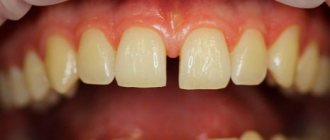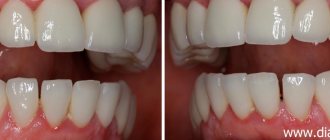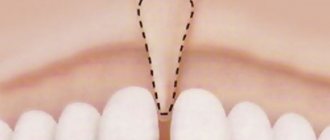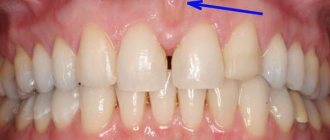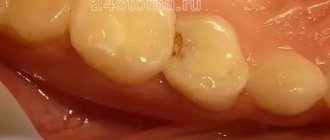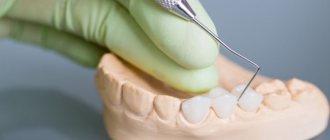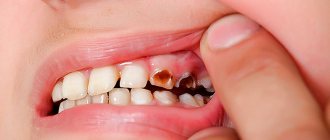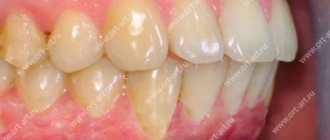What is the name of the gap between the teeth?
The scientific name for the gap between the upper front incisors is diastema. Dentists divide diastemas into true and false. The latter are temporary large gaps in children and adolescents, which appear due to too early loss of baby teeth, an incompletely formed bite and some other orthodontic phenomena, but disappear naturally over time. True diastemas in children and adults are gaps between the front teeth, which are corrected only after certain treatment.
As for the enlarged spaces between the lateral teeth, they are called trema; they arise due to the beginnings of “extra” teeth and other disturbances during the formation of the bite. Tremas can also appear after the loss or removal of one or more teeth, when the remaining teeth “diverge”, taking up the vacant space.
Types of diastemas
Diastema can be false or true:
- False is typical for children during the period of change from a temporary bite to a permanent one. In other words, it can occur in a child whose baby teeth have not yet been replaced.
- The situation is different with true diastema. It appears in adulthood and can have different forms, in particular, asymmetrical or symmetrical. This anomaly does not disappear on its own; it can only be removed with the help of qualified dentists.
Why did gaps appear between teeth?
In childhood, a gap between the front teeth most often appears when the frenulum of the upper lip is attached too low - almost between the teeth. This applies to the front teeth. Another common reason why gaps appear between a child’s teeth is the buds of “extra” teeth that form in the jaw bone and prevent the teeth from closing together. However, very often a large gap between the teeth, both front and side, in children and even adolescents is a temporary phenomenon and disappears on its own when the bite is finally formed.
At the same time, in many cases, the gap remains in adulthood, if it is not very large and the rest of the smile is proportional, it is even considered a kind of highlight.
Treatment
Correcting gaps between teeth in children often requires the participation of not only an orthodontist, but also dentists of other specializations: therapists, surgeons, orthopedists and periodontists.
After eliminating the cause, the incisors are shifted to the center. In childhood, this can be done with the help of:
- orthodontic devices with wire spring arms;
- bracket systems;
- elastic mouth guards
The sooner parents seek help, the sooner and at less cost a positive result will be achieved. Experts emphasize that regular observation by a dentist is a guarantee of the harmonious development of the dental system.
The Shifa clinic provides all types of services to restore the aesthetics of the dentition. Our specialists regularly improve their professionalism in Russia and abroad, and are familiar with the latest achievements in the field of dentistry. And computer modeling, which is widely practiced at the Shifa clinic, allows us to assess its prognosis even before the start of treatment and draw up an optimal correction scheme.
What does a gap between teeth mean?
As we have already said, large gaps between the teeth may mean that there are rudiments of “extra” teeth in the jaw bone. This phenomenon can be easily determined using an x-ray; it can also reveal another reason for the formation of a gap between the front incisors - an overdeveloped bone septum. But most often, diastemas arise from a low-attached frenulum of the upper lip. In many cases, eliminating gaps between teeth corrects not only the aesthetics of the smile, but also functional problems - speech defects caused by diastema, malocclusion and others. In addition, quite often people who are critical of their appearance consider their gaps between their teeth to be an obvious defect, which leads to decreased self-esteem and psychological problems. In any case, diastemas and trema are treatable. At your request, the doctor will always be able to remove the gap between the front teeth, even if your case is not critical and does not threaten health problems.
Diagnosis of diastema
Often the diastema is too noticeable to the naked eye - when smiling, it looks like a black triangle between the front central teeth . Diagnosis of diastema is accompanied by identifying the causes of the anomaly . The development of the disease can be noticed by the patient himself, revealing an increase in the gap between the teeth when brushing or flossing. Additionally, strengthening of the diastema will be detected by the dentist during regular examination.
During diagnosis, the most optimal treatment method is selected for each specific case, so that such treatment can best meet the needs of individual patients.
How to remove a gap between teeth?
If you are unhappy with the gap between your front teeth or want to get rid of three, consult a dentist. At the first appointment, he will determine the reason why you have a gap between your front teeth or gaps between your side teeth, and will draw up a treatment plan. An x-ray or orthopantomogram may be required. Next, the doctor decides how to correct the gaps between the teeth in a particular case.
If the cause of the diastema is the frenulum of the upper lip, then correcting the gap between the teeth will require plastic surgery of the frenulum and minor orthodontic treatment. Trimming the frenulum in modern dentistry is performed bloodlessly and painlessly using a laser, and braces will help “move” the teeth. If you are concerned about your appearance during treatment, the orthodontist will advise you to use lingual braces - they are attached to the back surface of the teeth and are completely invisible. Sometimes you can do without braces at all; in such cases, transparent aligners are used.
If the gap is formed due to an overdeveloped bone septum, the intervention of an oral and maxillofacial surgeon may be required. But, as a rule, the problem of the gap between the front incisors can be solved very quickly by replacing the front teeth with ultra-modern restorations, for example, composite veneers.
Adhesive treatment method
The peculiarity of adhesive dentistry lies in the installation of lumineers, which, similar to veneers, gradually reduce crevices. Lumineers are plates of composite resins of minimal thickness, made to the shape of a cleft in a particular person’s teeth. Any lumineers are made only to order and are given a shade similar to the adjacent areas of the patient’s enamel. This allows you to give the smile of a particular person the most natural look.
Closing gaps using the adhesive method is the fastest way to eliminate gaps. The advantage of the technique lies in the absence of the need to remove dental tissue, which is an integral part of the procedure for installing dental crowns, and sometimes porcelain veneers. As for the disadvantages of the procedure, lumineers provide only a temporary effect. In the future, the teeth will be ground down again and a new layer of composite resins will be placed to refresh your smile.
Photos of stars with a gap between their teeth
Many stars not only do not seek to correct the gap between their teeth, but also insist that this is their distinctive feature, such as Lily Aldridge, who forbids photographers to “Photoshop” her smile. Dentists have different opinions on this matter: some consider the gap between the teeth a defect and insist on correcting it, others believe that if the increased gap between the teeth does not interfere with its owner’s life, then it is not worth touching it and once again injuring the oral cavity.
Cher Lloyd
A popular participant in the English release of the cult show X Factor chose to get rid of the gap between her teeth using aesthetic teeth extensions and, I must admit, she made the right choice.
Zac Efron
The reason why Zac Efron decided to fix the gap between his front teeth is clear. Shcherbinka gave him a too immature look, while the actor dreamed of serious roles in films. And in order for dreams to come true, you have to sacrifice something.
Madonna
Madonna has never had any serious problems with her teeth, except for a small gap. But over the years, she still needed the help of an esthetician dentist. Madonna had the shape and color of her teeth corrected, but the gap between her teeth remained, which looks very natural and does not spoil her at all.
Reasons for the anomaly
A large distance between the front teeth can appear due to various factors:
- too small teeth with a large jaw volume;
- intrauterine disorders during the formation of the dentition;
- a large frenulum that connects the inner surface of the lip and gum;
- formation of an incorrect swallowing reflex (if during swallowing the tongue rests on the front teeth);
- bad habits that develop in childhood (prolonged use of pacifiers, bottles and other means);
- periodontal diseases, as a result of which the volume of bone tissue decreases;
- incomplete use of the braces system, when teeth move apart due to failure of the retention period;
- functional changes in children during the formation of temporary occlusion.
Why does a large sagittal fissure form?
An increase in the distance between the incisors of the upper and lower jaw can be formed under different conditions: 1. A large upper jaw, which does not correspond to the lower jaw (macrognathia of the upper jaw) 2. A small lower jaw - does not correspond to the size of the upper one (micrognathia of the lower jaw) 3. The upper incisors are too pronounced forward tilt (the so-called protrusion of the incisors) 4. A combination of the above
The most common causes of the formation of a sagittal fissure 1. Impaired nasal breathing (adenoids, allergic rhinitis, etc.) 2. Serious injuries to the maxillofacial area 3. Bad habits (finger sucking, pacifiers in children over 1.5-2 years old, biting the lower lip etc.) 4. Hereditary factor, developmental defects
What is a diastema?
Diastema between teeth is a common and very controversial disease in dentistry. There was a time when no treatment was carried out to normalize the position of the teeth. But doctors came to the conclusion that treatment is necessary, since speech function is impaired, and psychological difficulties arise due to aesthetic defects.
Diastema can be true or false:
- True occurs when the bite is formed.
- False occurs when changing teeth - does not require treatment and goes away on its own.
There are also symmetrical and asymmetrical diastemas depending on the position of the teeth.
Classification of diastemas
The phenomenon can be classified according to several fundamental criteria. Treatment is prescribed after the type of disease has been established and the individual characteristics of the patient have been clarified.
At the time of the event:
- False - pathology is characteristic of an early age, when the bite has not yet formed. During the process of changing teeth, it disappears on its own, without outside intervention.
- True - develops after a change of teeth and the formation of a bite, as well as in adults due to injuries, periodontal pathologies or premature prosthetics.
Important. In adults, a crack that appears will not disappear on its own. To correct the defect, you need to visit a doctor.
By location:
- symmetrical - the incisors are located symmetrically relative to each other and to the conventional center of the dentition;
- asymmetrical - one of the incisors deviates to the side, the second takes a natural position.
According to the position of teeth and roots:
- Lateral deviation of the crown. Assumes lateral deflection of the incisors with correct root position. This usually happens with extra teeth. The diastema is usually small.
- Lateral body movement. This is a lateral displacement of the tooth along with the root. One reason is hardened bone tissue along the central suture, which prevents teeth from erupting in the right place.
- Medial inclination of central incisal crowns is the most difficult case. Both teeth and roots shift. In this case, the crowns can expand to the sides or move around their own axis.
